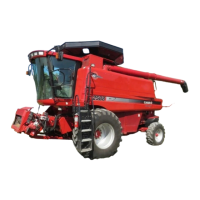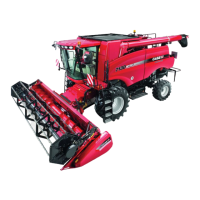TROUBLESHOOTING
25
Evaluating Grain Loss and Combine Performance (cont.)
A structured method of determining the source of loss is essential prior to making any adjustment to reduce loss. The illustration
demonstrates how to make an accurate assessment of the source of harvest loss.
The number of seeds counted in each area indicated represents loss in various stages of harvest:
Area A: Pre-harvest loss in standing crop, prior to contact with the reel.
Area B: Pre-harvest + Header loss. (Header loss = B – A) Loss occurring at the header due to shatter, dropped heads.
Area C: Pre-harvest + Header + Separator Loss. (Separator loss = C – B – A) Separator loss will not be isolated to the rotor or
cleaning system.
Remove straw spreaders. Enter an average area of the field, away from edges. Harvest a full swath, at normal
operating speed. Travel a minimum of approximately two combine lengths into the field after the machine is full
and delivering grain to the grain tank. Stop ground travel and the separator.
Back up approximately one combine
length. Safely stop the combine, and
perform seed loss evaluation.
Isolating Separator Loss
Separator loss can be isolated to rotor or cleaning system loss
in either of two ways.
1. Note the current chaffer and sieve settings. Open shoe
and chaffer sieves fully, and repeat the test as illustrated.
If observed separator loss is unchanged, loss is coming
from the rotor. If loss decreases, observed loss from first
test was from the cleaning system.
2. Perform the initial test with straw spreaders installed. Made
sure the separator has stopped before backing away from
cut crop. Observed loss in Area “C” is from the sieves
(cleaning system). Observed loss in Area “D” is rotor loss
that was spread across the width of the machine by the
straw spreaders.
Determine the Amount of Loss at Each Source
The next step is to count the grains lost on the ground in each
“counting area.” Each “counting area” should be equal to
about 10 square feet.
To convert the amount of loss you find at any point to bushels,
refer to the seed loss tables in your Operator’s Manual. Losses
should be checked in several areas and averaged to eliminate
the effects of any uneven feeding.
Make the Proper Adjustments
Once the loss counts have been performed as described,
required areas of attention will be identified.
• To reduce header losses, make sure header is adjusted
properly as explained in the
Operator’s Manual
• Before making adjustments for separator losses, be sure
there are no grain leaks due to missing bolts, open clean out
doors, or other obvious causes
• For adjustments to the rotor and cleaning system, see your
Operator’s Manual. For additional separator adjustments and
recommendations, see tables on pages 17 through 21.

